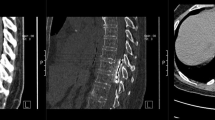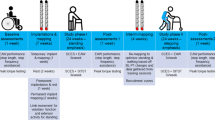Abstract
Study design
We retrospectively analyzed a database of implanted pulse generators (IPGs) for spinal cord stimulation (SCS) implanted by a single surgeon (NDT). We additionally report a series of five illustrative patient cases.
Objectives
The electronics of SCS IPGs are susceptible to damage when implanted patients undergo surgery. Some SCSs have a dedicated surgery mode, while others recommend turning the SCS off to protect it from damage. IPG inactivation may require resetting or replacement surgery. We aimed to explore the prevalence of this real-world problem which has not been studied.
Setting
Pittsburgh, Pennsylvania.
Methods
Using a single surgeon SCS database, we identified cases of IPG inactivation after a non-SCS surgery and analyzed the management. We then reviewed the charts of five illustrative cases.
Results
Among 490 SCS IPG implantations between 2016-2022, 15 (3%) of the 490 patients’ IPGs became inactivated after another non-SCS surgery. 12 (80%) required surgical IPG replacement, while 3 (20%) were able to have their IPG function restored non-operatively. In cases analyzed thus far, surgery mode was often not activated prior to surgery.
Conclusion
SCS IPG inactivation by surgery is not a rare problem and is presumably engendered by monopolar electrocautery. Premature IPG replacement surgery carries risks and reduces the cost-effectiveness of SCS. Awareness of this problem may prompt more preventative measures to be taken by surgeons, patients, and caretakers, and encourage technological advances to render IPGs less vulnerable to surgical tools. Further research is needed to determine what quality improvement measures could prevent electrical damage to IPGs.
This is a preview of subscription content, access via your institution
Access options
Subscribe to this journal
Receive 1 print issues and online access
We are sorry, but there is no personal subscription option available for your country.
Buy this article
- Purchase on Springer Link
- Instant access to full article PDF
Prices may be subject to local taxes which are calculated during checkout
Similar content being viewed by others
Data availability
Data are available from the corresponding author on reasonable request.
References
Amirdelfan K, Yu C, Doust MW, Gliner BE, Morgan DM, Kapural L, et al. Long-term quality of life improvement for chronic intractable back and leg pain patients using spinal cord stimulation: 12-month results from the SENZA-RCT. Qual Life Res. 2018;27:2035–44.
Kemler MA, Barendse GA, van Kleef M, de Vet HC, Rijks CP, Furnée CA, et al. Spinal cord stimulation in patients with chronic reflex sympathetic dystrophy. N Engl J Med. 2000;343:618–24.
North RB, Kidd DH, Farrokhi F, Piantadosi SA. Spinal cord stimulation versus repeated lumbosacral spine surgery for chronic pain: a randomized, controlled trial. Neurosurgery. 2005;56:98–106.
de Vos CC, Meier K, Zaalberg PB, Nijhuis HJ, Duyvendak W, Vesper J, et al. Spinal cord stimulation in patients with painful diabetic neuropathy: a multicentre randomized clinical trial. Pain. 2014;155:2426–31.
Zipes DP, Svorkdal N, Berman D, Boortz-Marx R, Henry T, Lerman A, et al. Spinal cord stimulation therapy for patients with refractory angina who are not candidates for revascularization. Neuromodulation. 2012;15:550–8.
Kumar K, Hunter G, Demeria D. Spinal cord stimulation in treatment of chronic benign pain: challenges in treatment planning and present status, a 22-year experience. Neurosurgery. 2006;58:481–96.
Mekhail NA, Mathews M, Nageeb F, Guirguis M, Mekhail MN, Cheng J. Retrospective review of 707 cases of spinal cord stimulation: indications and complications. Pain Pr. 2011;11:148–53.
Gazelka HM, Freeman ED, Hooten WM, Eldrige JS, Hoelzer BC, Mauck WD, et al. Incidence of clinically significant percutaneous spinal cord stimulator lead migration. Neuromodulation. 2015;18:123–5.
Harned ME, Gish B, Zuelzer A, Grider JS. Anesthetic considerations and perioperative management of spinal cord stimulators: literature review and initial recommendations. Pain Physician. 2017;20:319–29.
von Olshausen G, Rondak IC, Lennerz C, Semmler V, Grebmer C, Reents T, et al. Electromagnetic interference in implantable cardioverter defibrillators: present but rare. Clin Res Cardiol. 2016;105:657–65.
Terada Y, Miyashita T, Nagamine Y, Goto T. A modified algorithm for choosing the most appropriate intraoperative pacemaker mode for patients with permanent pacemaker in non-cardiac surgery. J Anesth. 2021;35:145–9.
Suresh M, Benditt DG, Gold B, Joshi GP, Lurie KG. Suppression of cautery-induced electromagnetic interference of cardiac implantable electrical devices by closely spaced bipolar sensing. Anesth Analg. 2011;112:1358–61.
Neubauer H, Wellmann M, Herzog-Niescery J, Wutzler A, Weber TP, Mügge A, et al. Comparison of perioperative strategies in ICD patients: The perioperative ICD management study (PIM study). Pacing Clin Electrophysiol. 2018;41:1536–42.
Eldabe S, Buchser E, Duarte RV. Complications of spinal cord stimulation and peripheral nerve stimulation techniques: a review of the literature. Pain Med. 2015;17:325–36.
North RB, Parihar HS, Spencer SD, Spalding AF, Shipley J. Cost-effectiveness model shows superiority of wireless spinal cord stimulation implantation without a separate trial. Neuromodulation. 2021;24:596–603.
Author information
Authors and Affiliations
Contributions
JNN acquired and analyzed the database findings and patients charts, prepared and formatted the manuscript. NE assisted with preparation and editing of the manuscript. RB assisted with preparation and editing of the manuscript. MP provided clinical insight and helped conceptualize the investigation. NDT is the senior author and helped conceptualize the investigation and contributed to manuscript editing and formatting.
Corresponding author
Ethics declarations
Competing interests
NDT is on the surgeon advisory board at Boston Scientific and is a consultant for Abbot Neuromodulation.
Ethical approval
Conducted in accordance with the Allegheny Health Network Institutional Review Board, IRB #2022-250.
Additional information
Publisher’s note Springer Nature remains neutral with regard to jurisdictional claims in published maps and institutional affiliations.
Supplementary information
Rights and permissions
Springer Nature or its licensor (e.g. a society or other partner) holds exclusive rights to this article under a publishing agreement with the author(s) or other rightsholder(s); author self-archiving of the accepted manuscript version of this article is solely governed by the terms of such publishing agreement and applicable law.
About this article
Cite this article
Norris, J.N., Esplin, N., Bharthi, R. et al. Inactivation of spinal cord stimulator implanted pulse generators after elective surgery: an under-recognized problem. Spinal Cord Ser Cases 9, 29 (2023). https://doi.org/10.1038/s41394-023-00591-5
Received:
Revised:
Accepted:
Published:
DOI: https://doi.org/10.1038/s41394-023-00591-5



